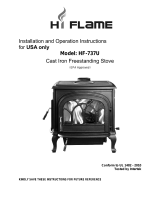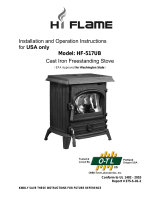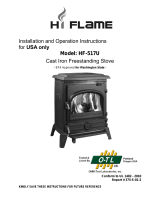
HearthStone Quality Home Heating Products Inc ® Model 8220
20
PRIMARY AIR CONTROL: This feature is
located on the lower portion of the ash door of
the stove. The primary air control allows you to
regulate the amount of air entering the firebox.
Generally speaking, the more air allowed into
the firebox, the faster and hotter the rate of burn;
conversely, less air creates a slower burn. Push
the lever to the left to open the primary air
control; push the lever to the right of the stove
to close the primary air control.
ASH PAN: The ash pan is located under the
firebox door. The ash pan collects burned ash
from a fire and allows you to conveniently
remove the ash from your wood stove. The ash
pan is easy to remove. Sift the ashes across the
grate and into the ash pan, then rotate the ash
door handle to the 9:00 o’clock and pull to open.
Remove the ash pan by grabbing the handle and
sliding it out carefully. After you have disposed
of the ashes, push the ash pan all the way into
the stove and close the ash door by turning the
handle to the 6 o’clock position.
Remove ashes when the stove is cold. If the ash
pan is warm, use protective fireplace gloves.
Exercise extreme caution when handling,
storing or disposing of ashes.
CHOOSING FIREWOOD
Your Deva 100 cookstove is designed to only
burn firewood-also known as cordwood.
▌ CAUTION:
DO NOT USE CHEMICALS OR
FLAMMABLE FLUIDS SUCH AS
GASOLINE, NAPHTHA, KEROSENE,
CHARCOAL LIGHTER FLUID OR
ENGINE OIL TO START A FIRE. DO
NOT USE CHARCOAL, PELLETS,
COAL, ARTIFICIAL LOGS OR ANY
OTHER MATERIALS AS FUEL; THEY
ARE NOT SAFE. DO NOT BURN
GARBAGE.
The quality of your firewood affects heat output,
duration of burn and performance of your stove.
Softwoods generally burn hotter and faster,
while hardwoods burn longer and produce more
coals. Density and moisture content are two
critical factors to consider when purchasing
wood for your stove.
The following is a list of wood species and their
relative BTU (British Thermal Unit) content.
The higher the BTU the longer the burn.
Firewood with higher BTUs is generally
considered more ideal for a wood stove.
HIGH: Apple, Black Birch, Hickory, Locust,
White Oak, Black Beech, Mesquite
MEDIUM HIGH: White Ash, Beech, Yellow
Birch, Sugar Maple, Red Oak
MEDIUM LOW: Black Ash, White Birch, Grey
Birch, Elm, Norway Pine, Pitch Pine, Black
Cherry, Soft Maple, Tamarack
LOW: White Pine, White Cedar, Balsam Fir,
Spruce, Aspen, Basswood, Butternut, Hemlock
Moisture content also plays a key role in the
performance of your stove. Wood freshly cut
from a living tree (green wood) contains a great
deal of moisture. As you might expect, green
wood has difficulty burning and should be
seasoned before using it in your cookstove. To
properly season green wood, it should be split,
stacked and allowed to air dry for a period of
one year.
Stack the firewood on skids or blocks to keep it
off the ground, cover only the top of the stack.
Plastic or tarps that cover the sides of the
woodpile trap moisture and
prevent the wood
from drying. As for stacking, an old Vermonter
said, "The spaces between the logs should be
large enough for a mouse to get through, but not
for the cat that's chasing it."
Firewood should not be stored within the stove's
specified clearances to combustible materials.
























